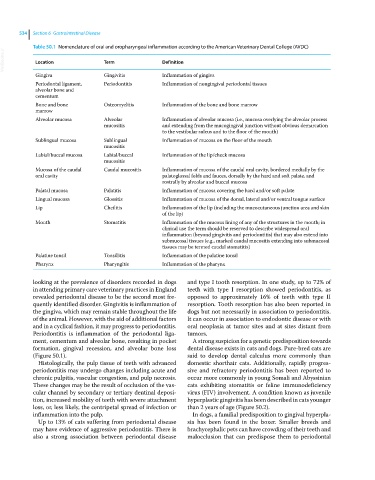Page 566 - Clinical Small Animal Internal Medicine
P. 566
534 Section 6 Gastrointestinal Disease
Table 50.1 Nomenclature of oral and oropharyngeal inflammation according to the American Veterinary Dental College (AVDC)
VetBooks.ir Location Term Definition
Gingiva Gingivitis Inflammation of gingiva
Periodontal ligament, Periodontitis Inflammation of nongingival periodontal tissues
alveolar bone and
cementum
Bone and bone Osteomyelitis Inflammation of the bone and bone marrow
marrow
Alveolar mucosa Alveolar Inflammation of alveolar mucosa (i.e., mucosa overlying the alveolar process
mucositis and extending from the mucogingival junction without obvious demarcation
to the vestibular sulcus and to the floor of the mouth)
Sublingual mucosa Sublingual Inflammation of mucosa on the floor of the mouth
mucositis
Labial/buccal mucosa Labial/buccal Inflammation of the lip/cheek mucosa
mucositis
Mucosa of the caudal Caudal mucositis Inflammation of mucosa of the caudal oral cavity, bordered medially by the
oral cavity palatoglossal folds and fauces, dorsally by the hard and soft palate, and
rostrally by alveolar and buccal mucosa
Palatal mucosa Palatitis Inflammation of mucosa covering the hard and/or soft palate
Lingual mucosa Glossitis Inflammation of mucosa of the dorsal, lateral and/or ventral tongue surface
Lip Cheilitis Inflammation of the lip (including the mucocutaneous junction area and skin
of the lip)
Mouth Stomatitis Inflammation of the mucous lining of any of the structures in the mouth; in
clinical use the term should be reserved to describe widespread oral
inflammation (beyond gingivitis and periodontitis) that may also extend into
submucosal tissues (e.g., marked caudal mucositis extending into submucosal
tissues may be termed caudal stomatitis)
Palatine tonsil Tonsillitis Inflammation of the palatine tonsil
Pharynx Pharyngitis Inflammation of the pharynx
looking at the prevalence of disorders recorded in dogs and type I tooth resorption. In one study, up to 72% of
in attending primary care veterinary practices in England teeth with type I resorption showed periodontitis, as
revealed periodontal disease to be the second most fre opposed to approximately 16% of teeth with type II
quently identified disorder. Gingivitis is inflammation of resorption. Tooth resorption has also been reported in
the gingiva, which may remain stable throughout the life dogs but not necessarily in association to periodontitis.
of the animal. However, with the aid of additional factors It can occur in association to endodontic disease or with
and in a cyclical fashion, it may progress to periodontitis. oral neoplasia at tumor sites and at sites distant from
Periodontitis is inflammation of the periodontal liga tumors.
ment, cementum and alveolar bone, resulting in pocket A strong suspicion for a genetic predisposition towards
formation, gingival recession, and alveolar bone loss dental disease exists in cats and dogs. Pure‐bred cats are
(Figure 50.1). said to develop dental calculus more commonly than
Histologically, the pulp tissue of teeth with advanced domestic shorthair cats. Additionally, rapidly progres
periodontitis may undergo changes including acute and sive and refractory periodontitis has been reported to
chronic pulpitis, vascular congestion, and pulp necrosis. occur more commonly in young Somali and Abyssinian
These changes may be the result of occlusion of the vas cats exhibiting stomatitis or feline immunodeficiency
cular channel by secondary or tertiary dentinal deposi virus (FIV) involvement. A condition known as juvenile
tion, increased mobility of teeth with severe attachment hyperplastic gingivitis has been described in cats younger
loss, or, less likely, the centripetal spread of infection or than 2 years of age (Figure 50.2).
inflammation into the pulp. In dogs, a familial predisposition to gingival hyperpla
Up to 13% of cats suffering from periodontal disease sia has been found in the boxer. Smaller breeds and
may have evidence of aggressive periodontitis. There is brachycephalic pets can have crowding of their teeth and
also a strong association between periodontal disease malocclusion that can predispose them to periodontal

